Jerry Seinfeld has a joke that says the reason Superman wears a disguise is because no good deed goes unpunished: “Superman, thanks for saving my life, but did you have to come through my wall? I’m renting here, I’ve got a security deposit. What am I supposed to do?” If you’ve ever had a sprinkler system extinguish a fire, you might understand the feeling. The alternative is obviously way worse, but your stuff is still waterlogged. That’s why London-based Plumis thinks its Automist system, first covered by Gizmag, offers a better solution. It sprays the fire, not the entire room. The company says its retrofittable mister uses 90 percent less water than traditional home sprinklers.
There aren’t a ton of houses with sprinkler systems in place — only about 4.6 percent of U.S. homes have them, according to a 2009 American Housing Survey — but the National Fire Protection Association says they can cut the risk of death by 80 percent. And while they also reduce the amount of property damage, again, you’re still left with soggy carpets.
Instead of nozzles mounted in the ceiling, Automist uses wall units with sensors. If the heat alarm triggers, the Automist Smartscan uses an infrared sensor to detect the fire’s location, then the nozzle swivels and starts spraying. Instead of a gushing torrent, though, the water passes through the special nozzle at a pressure high enough to atomize it, turning it into a mist. It’s still effective at fighting the fire, but uses just 1.5 gallons of water per minute, compared to the 8 to 24 gallons a typical sprinkler uses. Automist also has a faucet version, enabling water to spray out of your kitchen tap to fight fires in a room where many disasters start.
To get the system installed, you have to go through one of Plumis’ partners, and there seems to be only one in the U.S. at the moment. And while you don’t need to add a whole lot of piping (it hooks up to your existing water supply with a hose), it does need a 230-volt electrical supply, which isn’t standard in the U.S.
Because it’s a less intensive installation than sprinklers, the Automist system should also cost less, but we’ve reached out to Qdot Engineering, the U.S. installer, for more information and will update when we hear back.


